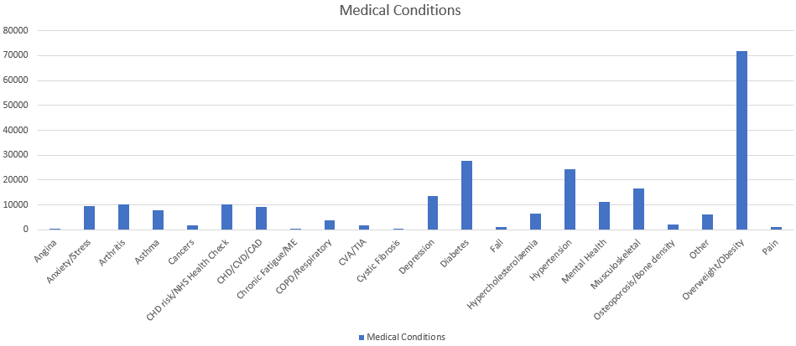People are often referred to services to assist in the treatment or management of their long-term conditions (health conditions). After analysing over 160,000 referral records we are able to provide a ranking of the most common conditions stated at the point of referral. We were amazed to see that over 235,000 medical conditions have been stated.
Number of referrals
At the time of writing we analysed 162,960 referrals from the ReferAll system. There is a spread of service within the system, typically, exercise referral, weight management, health trainers, smoking cessation and public health support services. The number of services total 171.
Stated medical conditions
From the referral data, we could ascertain that 237,589 medical conditions have been stated at the point of referral. Many people referred presented with 2 or more conditions which is often an inclusion criteria to gain access to the service. This demonstrates that the average referral presents with 1.4 medical conditions.
Services and methods are diverse as were the text of the medical condition. To smooth out the differences in naming conventions a mapping exercise was undertaken to map conditions back to a more consistent label. For example, the stated conditions “diabetes type 1” and “type 1 diabetes” were mapped to Diabetes.
So how do these conditions rank?
There were some obvious conditions that featured highly such as overweight.obesity, although there is still discussion as to whether obesity is a medical condition or not (we are not going to cover that in this blog post).
Interestingly, depression ranked lower than expected but it is not clear if services are wrongly categorising or preferring to categorise as anxiety/stress or mental health.
The chart below displays the number of times a medical condition has been stated.

The table below shows the same condtions ranked by occurrence.
|
Rank |
Condition |
Number |
|
1 |
OVERWEIGHT/OBESITY |
70089 |
|
2 |
DIABETES |
27786 |
|
3 |
HYPERTENSION |
24496 |
|
4 |
MUSCULOSKELETAL |
16473 |
|
5 |
DEPRESSION |
13717 |
|
6 |
MENTAL HEALTH |
11278 |
|
7 |
ARTHRITIS |
10218 |
|
8 |
CHD RISK/NHS HEALTH CHECK |
10070 |
|
9 |
ANXIETY |
9649 |
|
10 |
CHD/CVD/CAD |
9244 |
|
11 |
ASTHMA |
7907 |
|
12 |
HYPERCHOLESTEROLAEMIA |
6417 |
|
13 |
OTHER |
6082 |
|
14 |
COPD/RESPIRATORY |
3863 |
|
15 |
OSTEOPOROSIS/BONE DENSITY |
1997 |
|
16 |
CVA/TIA |
1947 |
|
17 |
CANCERS |
1804 |
|
18 |
PAIN |
1186 |
|
19 |
FALLS |
980 |
|
20 |
ANGINA |
539 |
|
21 |
CHRONIC FATIGUE/ME |
260 |
|
22 |
CYSTIC FIBROSIS |
2 |
It is clear to see that the most common condition is overweight/obesity. We were surprised to see diabetes in second place but many of our services aim to target people with diabetes so this may not be a surprise.
So, how do the top three conditions compare across the UK average?
| Condition | ReferAll Average | UK Average |
| Obesity | 43% | 63% |
| Diabetes | 17% | 5.3% |
| Hypertension | 15% | 24% |
With one exception (Diabetes) the data contained within ReferAll shows a considerably lower than average prevalence than the UK average. Looking more closely at diabetes many programmes within ReferAll are built to specifically target those with diabetes which goes some way to explain the higher than average percentage.
Summary
Recording medical conditions within a service provides the following benefits:
- Ensure safe and effective programming of the chosen intervention
- Provides service providers with data from which to target services
- Allows commissioners and other bodies to understand how services can impact on the treatment and management of conditions
If your scheme or service is struggling to record such data then please download our complimentary guide on effective referral schemes by clicking the image below. Or contact us via our website.

